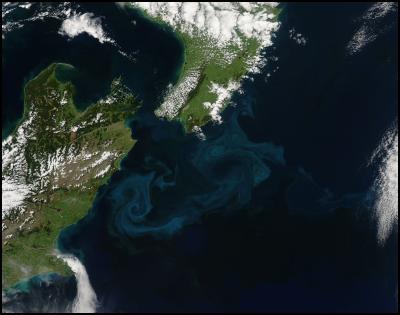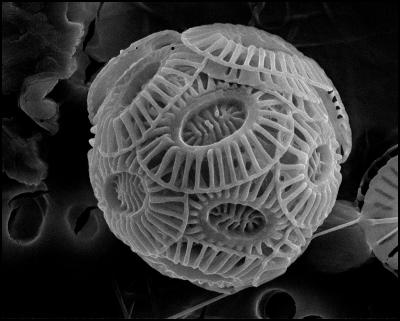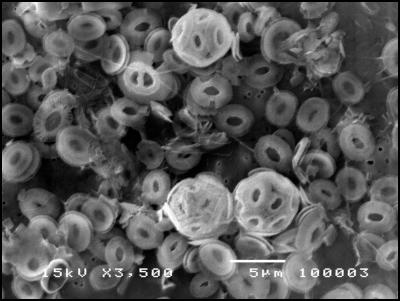Spectacular oceanic bloom identified
NIWA Media Release: 9 November 2009

Click for big version
NASA MODIS satellite image showing the bloom as at 25 October [credit: NASA]
Scientists at the National Institute of Water & Atmospheric Research (NIWA) have identified the source of the giant plankton bloom featuring in spectacular NASA satellite images.

Click for big version
Emiliana Huxleyi, the main species of coccolithophore identified by NIWA scientists from samples of a giant plankton bloom east of New Zealand [credit: NIWA]

Click for big version
A typical sample found within the bloom, showing the abundance of chalky scales from dead cells [credit: NIWA]
The NIWA deep water research vessel Tangaroa travelled through the bloom last week and collected water samples for analysis. Using a scanning electron microscope, NIWA scientist Dr Hoe Chang has now confirmed the bloom mainly contains two species of coccolithophores. Other microalgae such as diatoms were also present, but were not as abundant as coccolithophores.
These tiny plant cells (coccolithophores) are so small that about 200 of them side by side would fit in one millimetre. Each cell is covered by nine or ten tiny, overlapping scales (or “coccoliths”) of calcium carbonate. They are not toxic.
Hoe Chang says in the sample of water from within the region of the bloom the cell concentration was about 500 000 cells per litre – about 65 times higher in the bloom than outside it. The sample was chock full of scales from dead cells with an astounding 990 million coccoliths (calcium carbonate scales) per litre. That is about 37 000 times more plates inside the bloom than outside it. Dr Hoe Chang says that this means that the population in the bloom was ˜c`llapsing™ releasing the chalky scales from the cells and therefore giving a much brighter image from space.
Coccolithophores are vital food at the base of the marine food web. They are sensitive to the increasing acidity of the ocean, which results from the build-up of carbon dioxide in the atmosphere and makes it harder to form the carbonate scales. For this reason, scientists believe that these and other carbonate-forming marine life may decline in the future as the upper ocean absorbs increasing amounts of carbon dioxide. NIWA Principal Scientist, Dr Cliff Law, says we don™t yet know what caused this appearance of one of the largest recorded coccolithophore blooms in NZ waters, but factors such as ocean currents, favourable light, temperature, and nutrients are clearly important.
For
more information on research to investigate the effects of
ocean acidification on plankton in New Zealand waters,
see:
http://www.niwa.co.nz/our-science/oceans/research-projects/all/effects-of-ocean-acidification-on-plankton-in-new-zealand-waters
IMAGES ARE AVAILABLE from ftp://ftp.niwa.co.nz/niwamedia in a folder labelled “oceanic bloom”
NASA MODIS satellite
image showing the bloom as at 25 October [credit:
NASA]
For more information & terms of use see:
http://earthobservatory.nasa.gov
ENDS


 Commerce Commission: Commission Calls For Comments On Copper Access Deregulation
Commerce Commission: Commission Calls For Comments On Copper Access Deregulation New Zealand Association of Scientists: NZAS Supports Saving Biotechnology Capacity In Callaghan; Asks What Now For Applied Technology Group
New Zealand Association of Scientists: NZAS Supports Saving Biotechnology Capacity In Callaghan; Asks What Now For Applied Technology Group Stats NZ: Business Employment Data - December 2024 Quarter
Stats NZ: Business Employment Data - December 2024 Quarter Transpower: System Operator Launches Review Of Electricity Risk Forecasting Framework
Transpower: System Operator Launches Review Of Electricity Risk Forecasting Framework  The Conversation: NZ’s Glaciers Have Already Lost Nearly A Third Of Their Ice – As More Vanishes, Landscapes And Lives Change
The Conversation: NZ’s Glaciers Have Already Lost Nearly A Third Of Their Ice – As More Vanishes, Landscapes And Lives Change RBNZ: Reserve Bank Of New Zealand Welcomes The Release Of Te Ōhanga Māori 2023 Report
RBNZ: Reserve Bank Of New Zealand Welcomes The Release Of Te Ōhanga Māori 2023 Report



